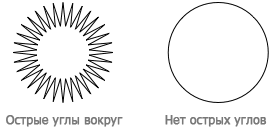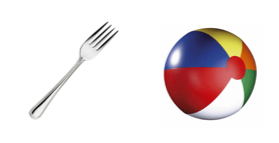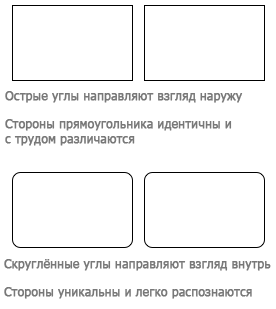Why rounded corners are easier to read
Nowadays, designers so often use rounded corners that they can already be considered the industrial standard, not a fashion trend. They are found not only in programs, but even in the design of hardware devices. What makes them so popular?
Everyone sees the aesthetic beauty of rounded corners, but not everyone is able to explain where this beauty comes from. The answer is literally in our eyes.
Rounded corners are more easily perceived by the brain.
Some experts believe that a figure with rounded corners is easier to perceive than a figure with sharp corners, because it requires less cognitive effort for visual processing. Vision quickly cope with the circle. Corner treatment involves more brain neurons [1] . Thus, figures with rounded corners are easier to process because they are closer to a circle than a regular polygon.
Scientific studies of angles conducted at the Barrow Institute of Neurology have shown that “perceived visibility of angles depends linearly on their sharpness. Acute angles cause stronger apparent visibility than obtuse angles ” [2] . In other words, the sharper the angle, the more it attracts attention. And the more he attracts attention, the more effort is spent on its visual processing.
')

Which object is easier to look at?
We are adapted to rounded corners.
Another explanation why we prefer rounded corners is that they are more natural for everyday objects in the surrounding world [3] . Rounded corners everywhere. As children, we quickly learned that sharp corners hurt, and rounded corners are safer. That is why when a child plays with a ball, most parents are calm. But if the child starts playing with the plug, the parents will try to pick up the plug so that it doesn’t accidentally hurt itself. In neurology, this is called a “avoidance reaction” to sharp corners. We tend to "avoid sharp corners, because in nature they can be dangerous" [4] .

What object do you trust your child?
Rounded corners make information easier to read.
Rounded corners are better suited for maps and charts, because it is easier for the eye to follow lines that “better fit the natural movements of the eyes and head” [5] . Sharp corners abruptly break the line and knock your eye out of the way, causing an unexpected pause when the line changes direction. And with rounded edges, the movement occurs smoothly.

Which diagram is more convenient for eyes?
Rounded corners are also convenient containers for information, because they direct the view to the center of the rectangle. Thus, attention concentrates on the content inside the container. They also facilitate the perception of which line belongs to which rectangle. In contrast to them, the sharp corners in the figures direct attention beyond the container, so that it is harder for the eyes to concentrate inside. At the same time, it is more difficult to understand which line belongs to which container if they are close to each other. The reason is that they are exactly the same, whereas in a figure with rounded edges the line smoothly turns in the direction of its container and everything becomes clear on an intuitive level.

Conclusion
Rounded corners are not just pleasing to the eye. They also facilitate the perception of graphics and information processing by the brain. There is no doubt that they look attractive, but these additional properties make them even more preferable for use in design. Now, when you talk to the client about the design with rounded edges, you will have additional arguments, besides that they just look good.
Links
[1] Realizations of Rounded Rectangles
[2] Corner salience varies linearly with corner angle during fl icker-augmented contrast
[3] Why Do We Love Rounded Corners?
[4] The NeuroFocus Study Reveals What Wrong With the Gap's New Brand Logo
[5] FMC Visualization Guidelines
Everyone sees the aesthetic beauty of rounded corners, but not everyone is able to explain where this beauty comes from. The answer is literally in our eyes.
Rounded corners are more easily perceived by the brain.
Some experts believe that a figure with rounded corners is easier to perceive than a figure with sharp corners, because it requires less cognitive effort for visual processing. Vision quickly cope with the circle. Corner treatment involves more brain neurons [1] . Thus, figures with rounded corners are easier to process because they are closer to a circle than a regular polygon.
Scientific studies of angles conducted at the Barrow Institute of Neurology have shown that “perceived visibility of angles depends linearly on their sharpness. Acute angles cause stronger apparent visibility than obtuse angles ” [2] . In other words, the sharper the angle, the more it attracts attention. And the more he attracts attention, the more effort is spent on its visual processing.
')

Which object is easier to look at?
We are adapted to rounded corners.
Another explanation why we prefer rounded corners is that they are more natural for everyday objects in the surrounding world [3] . Rounded corners everywhere. As children, we quickly learned that sharp corners hurt, and rounded corners are safer. That is why when a child plays with a ball, most parents are calm. But if the child starts playing with the plug, the parents will try to pick up the plug so that it doesn’t accidentally hurt itself. In neurology, this is called a “avoidance reaction” to sharp corners. We tend to "avoid sharp corners, because in nature they can be dangerous" [4] .

What object do you trust your child?
Rounded corners make information easier to read.
Rounded corners are better suited for maps and charts, because it is easier for the eye to follow lines that “better fit the natural movements of the eyes and head” [5] . Sharp corners abruptly break the line and knock your eye out of the way, causing an unexpected pause when the line changes direction. And with rounded edges, the movement occurs smoothly.

Which diagram is more convenient for eyes?
Rounded corners are also convenient containers for information, because they direct the view to the center of the rectangle. Thus, attention concentrates on the content inside the container. They also facilitate the perception of which line belongs to which rectangle. In contrast to them, the sharp corners in the figures direct attention beyond the container, so that it is harder for the eyes to concentrate inside. At the same time, it is more difficult to understand which line belongs to which container if they are close to each other. The reason is that they are exactly the same, whereas in a figure with rounded edges the line smoothly turns in the direction of its container and everything becomes clear on an intuitive level.

Conclusion
Rounded corners are not just pleasing to the eye. They also facilitate the perception of graphics and information processing by the brain. There is no doubt that they look attractive, but these additional properties make them even more preferable for use in design. Now, when you talk to the client about the design with rounded edges, you will have additional arguments, besides that they just look good.
Links
[1] Realizations of Rounded Rectangles
[2] Corner salience varies linearly with corner angle during fl icker-augmented contrast
[3] Why Do We Love Rounded Corners?
[4] The NeuroFocus Study Reveals What Wrong With the Gap's New Brand Logo
[5] FMC Visualization Guidelines
Source: https://habr.com/ru/post/126726/
All Articles